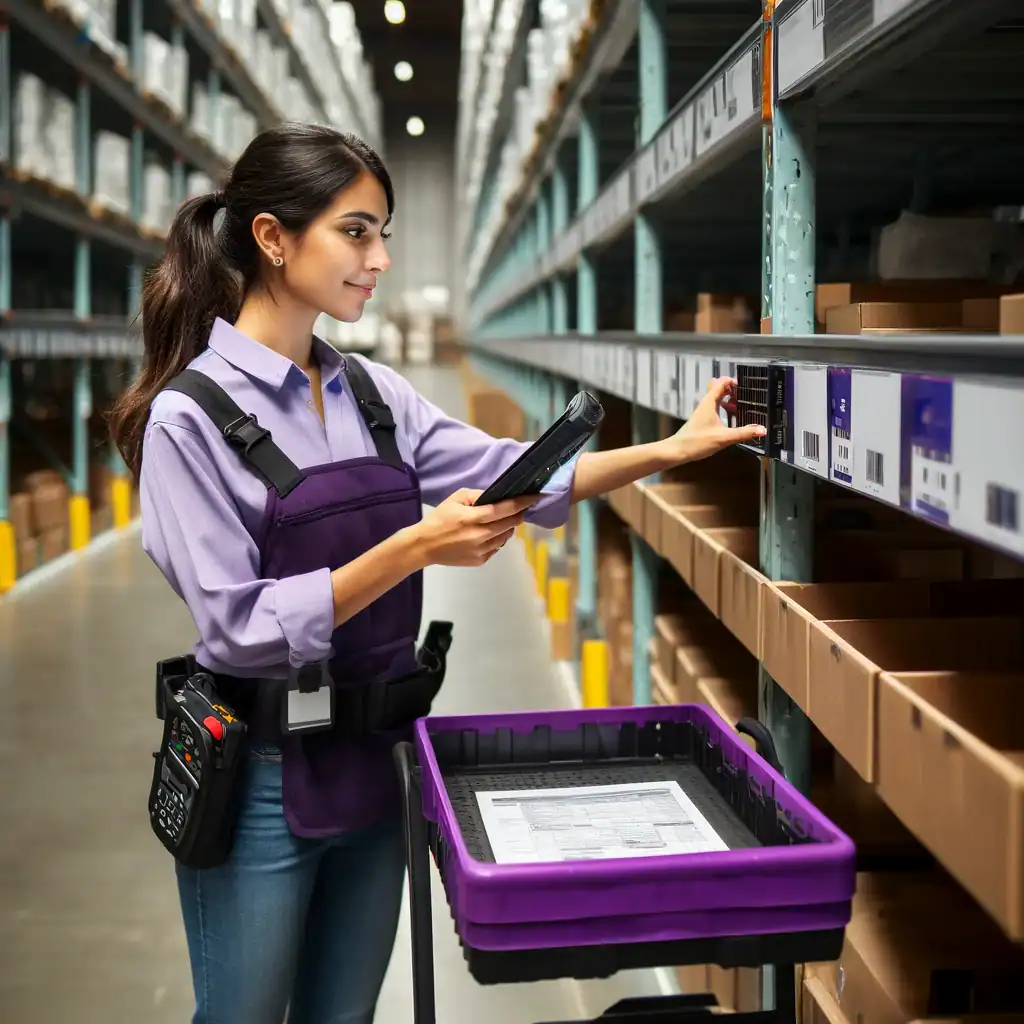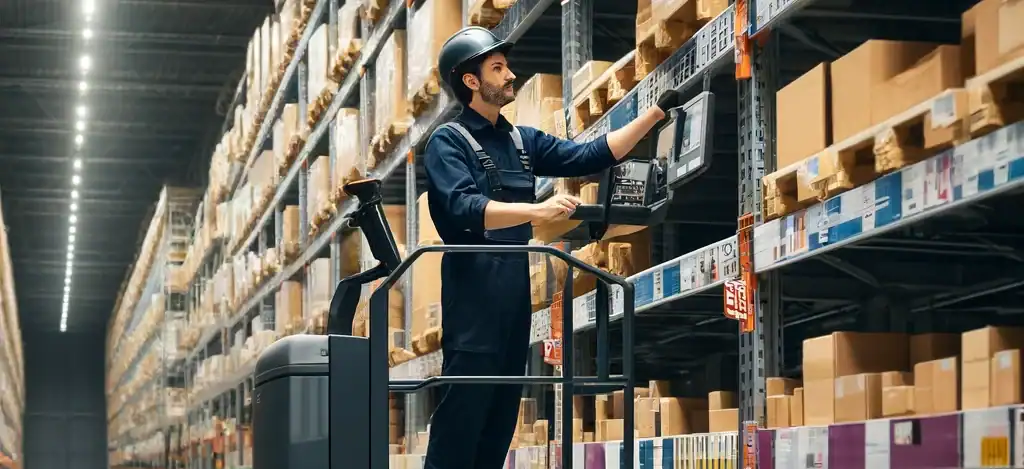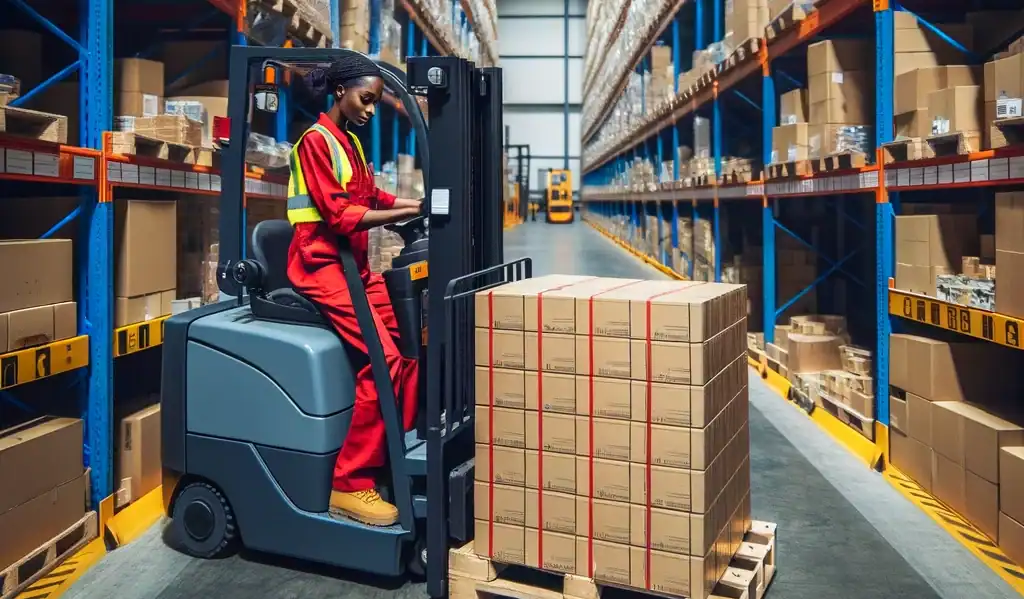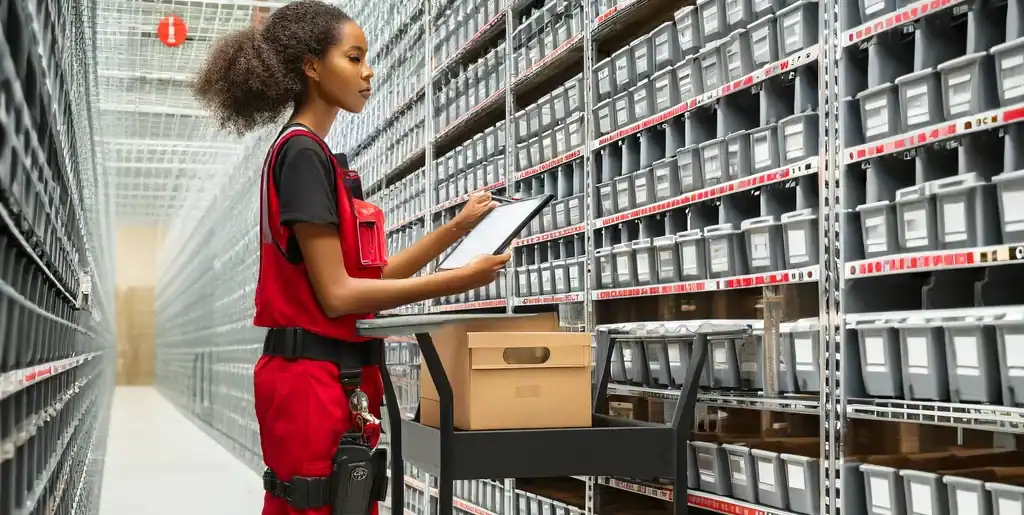Warehouse Order Picker: Master 15 Essential Picking Styles
In the heart of every bustling warehouse, the order picker plays a pivotal role, transforming the chaos of stocked shelves into the smooth flow of outgoing orders.
Table of Contents

This isn’t just about selecting items—it’s a finely tuned art that demands precision, speed, and an expert understanding of multiple picking strategies.
From the silent aisles of overnight shifts to the rapid pace of peak hours, order pickers are the unsung heroes ensuring that every item in your cart is picked perfectly.
In this post, we’ll unveil the 15 essential picking styles that every top-tier warehouse order picker must master to thrive in today’s fast-evolving logistics landscape.
Introduction
In the fast-paced realm of logistics, where precision and speed are paramount, the efficiency of warehouse operations critically depends on one fundamental task: order picking.
In this deep dive, we explore the array of picking methods—from the manual prowess of pick to pallet to advanced automated systems like pick to light.
Whether you’re an experienced warehouse order picker looking to refine your skills or an operations manager aiming to improve your operations, understanding these techniques will equip you to lead the charge in innovation and efficiency within the modern logistics landscape.
Picking Types: An In-depth Analysis
An order picker or order selector collects items in a warehouse to fulfill customer orders. This role is crucial in the e-commerce and distribution sectors. Here’s an overview of various picking methods you might find in a warehouse:
- Physical Requirements: Ability to handle heavy loads and operate a pallet jack or forklift.
- Demographics: Typically involves older, more experienced workers.
- Safety Challenges: Risk of injuries from heavy lifting and equipment operation.
- Equipment Needed: Pump jacks, pallet jacks, forklifts.
- Skills Necessary: Equipment operation, spatial awareness.

Methodology
An associate or pallet picker collect items directly from the storage shelves and place them onto a pallet. This method is particularly efficient for preparing large orders or when items are bulky and easier to handle in bulk.
By consolidating the items on a single pallet, the process minimizes the number of trips needed to transport goods, thereby increasing efficiency and reducing handling time.
Optimization
Pick-to-pallet can be optimized with warehouse management systems that direct the pickers along the most efficient routes through the warehouse.
This method helps maintain order accuracy and enhances the speed of the order fulfillment process, making it a preferred choice in settings where large-scale shipping operations are common.
Expert Advice
- Configure your desired travel path within your WMS system using “sequencing logic.” You want your pick path to start and end close to each other to avoid any ‘dead travel’ once the order(s) is complete.
- In the diagram below, the dark green represents your high velocity (A-type) SKUs, medium velocity (B-type) in light green, yellow for slow movers (C-type), and red for your low or no velocity SKUs (D-type). Click here to learn more about creating an ABC SKU analysis.
- The dotted red line displays your typical pick path while the green arrows represent your ultimate pick path. If your order(s) only contain A-type and B-type SKUs, then you may be able to shorten your travel path.
- Traveling down one aisle and back in another is a solid pick path. with no dead travel.
- Slot your A-type SKUs with high cube near the path beginning and your A-Type lower cube SKUs at the end. This reduces having to re-arrange products on the pallet.
- Set up your pick path with SKUs staged on both sides of the aisle and configure your picking sequence to “S pick,” which means you pick from both sides as you traverse the aisle.

- For configuring the S-pick, using the diagram above, I recommend sequencing the bay picks like this: Bay 1, Bay 2, Bay 4, Bay 3 which potentially keeps you on the same side of the aisle for two bays (multiple picks) versus Bay 1, Bay 2, Bay 3, Bay 4, called “Z-pick,” which bounces you back and forth between bays.
- Note: Profiling your higher velocity SKUs near the front of the pick path also reduces putaway travel. To learn more about putaway, check out our blog on directed putaway.
Pick to Cart

- Physical Requirements: Moderate physical mobility to maneuver pick carts.
- Demographics: Common among a diverse age group.
- Safety Challenges: Minimal, collision risks, ergonomic issues.
- Equipment Needed: Manual or motorized carts. (click link for 6 Rivers robotic carts)
- Skills Necessary: Organizational skills, basic physical stamina.
Pick-to-cart, a cornerstone of order fulfillment, utilizes rolling carts to collect items for multiple orders in one go. This method prioritizes efficiency by minimizing travel time and maximizing picker productivity, making it ideal for warehouses with high-volume picking and a focus on batch fulfillment.
Methodology
- Warehouse Management Systems (WMS) analyze incoming orders and generate pick lists, often grouped into batches based on shared characteristics.
- Pickers are assigned a cart with shelves, bins, or compartments.
- They navigate the picking zones, retrieving items for multiple orders within their assigned batch based on the pick list instructions.
- Pickers strategically place the retrieved items into the designated sections of the picking cart, ensuring accurate order association.
- Once complete, the cart is typically transported to a designated packing or consolidation area, where items are sorted and packed into individual orders.
Optimization
- WMS Optimization: Utilize WMS capabilities to strategically batch orders based on item location, pick frequency, and cart capacity, maximizing the number of items picked per trip.
- Pick Path Optimization: Ensure WMS maps efficient picking routes within zones, minimizing backtracking and travel time while collecting items for multiple orders on the cart.
- Cart Design and Optimization: Utilize carts specifically designed for picking efficiency, considering factors like compartment size, number of tiers, and maneuverability within the warehouse layout.
Expert Advice
- Invest in picker training: Train pickers on proper cart loading techniques for order organization and safe maneuvering within the warehouse.
- Implement visual order identification: Utilize clear labels or color-coding systems on the picking cart to help pickers easily identify designated sections for each order within the batch.
- Monitor pick-to-cart performance: Track metrics like picks per hour, accuracy per order, and cart utilization to identify potential bottlenecks and refine pick path optimization, batching strategies, or cart design considerations.
Pick to Tote
- Physical Requirements: Bending and lifting totes.
- Demographics: Younger workforce due to lower skill requirements.
- Safety Challenges: Back strain from repetitive motion.
- Equipment Needed: Totes, automated conveyor belts.
- Skills Necessary: Speed and accuracy, basic system navigation.

Pick-to-tote, a fundamental order fulfillment method, prioritizes organization and efficiency by directing pickers to place retrieved items into designated totes or bins. These totes represent individual customer orders, streamlining the consolidation process and ensuring accurate order fulfillment.
Methodology
- Warehouse Management Systems (WMS) analyze incoming orders and generate pick lists.
- Pickers navigate designated picking zones, retrieving items based on the pick list instructions.
- Unlike bulk picking methods, pickers place the retrieved items directly into pre-labeled totes assigned to specific customer orders.
- Once complete, the totes are typically sealed, manifested, and transported to a designated packing or consolidation area for further processing.
Optimization
- WMS Integration: Ensure seamless integration between WMS and tote management systems for accurate order allocation, clear tote labeling, and efficient picking sequences.
- Pick Path Optimization: Utilize WMS capabilities to map efficient picking routes within zones, minimizing travel time and maximizing item collection for designated totes.
- Tote Size Optimization: Analyze historical data and order profiles to select appropriate tote sizes, minimizing wasted space and ensuring efficient tote utilization.
Expert Advice
- Invest in clear tote labeling: Implement a clear and standardized system to expedite order identification and minimize picking errors.
- Utilize tote management systems: Consider integrating a tote management system to track tote location and status, streamline order consolidation, and minimize lost or misplaced totes.
- Monitor pick-to-tote performance: Track metrics like picks per hour, accuracy, and tote utilization to identify potential bottlenecks and refine pick path optimization, tote size selection, or labeling strategies.
Pick to Light

- Physical Requirements: Minimal, as it’s often partially automated.
- Demographics: Typically middle age female workers.
- Safety Challenges: Minimal physical risks.
- Equipment Needed: LED displays, sensors.
- Skills Necessary: Quick response times, attention to detail.
Pick-to-light, a technology-driven order fulfillment method, utilizes light-directed guidance to enhance picker efficiency and minimize errors. This approach leverages strategically placed lights and buttons at storage locations, offering a clear and intuitive picking experience ideal for warehouses with high-volume picking, complex layouts, or a focus on accuracy.
Methodology
- Warehouse Management Systems (WMS) analyze incoming orders and generate pick lists.
- Pickers navigate designated picking zones equipped with pick-to-light shelving or workstations.
- Light indicators illuminate at specific locations corresponding to the required items and quantities on the pick list.
- Pickers locate the illuminated item, verify the accuracy, and then pick the designated quantity.
- Once picked, pickers often confirm their selection by pressing a button next to the light, signaling the system and potentially illuminating the next pick location.
Optimization
- WMS Integration: Ensure seamless integration between WMS and pick-to-light systems for real-time order updates, accurate light activation, and optimized picking sequences.
- Pick Path Optimization: Utilize WMS capabilities to map efficient picking routes within zones, minimizing travel time and maximizing picking efficiency.
- Light System Layout Optimization: Strategically design the pick-to-light layout for optimal reach and visibility, minimizing picker movement and fatigue.
Expert Advice
- Invest in picker training: Train pickers on proper picking procedures with pick-to-light systems, including light signal recognition, quantity confirmation methods, and error correction protocols.
- Maintain a clean and organized picking zone: Ensure optimal light visibility by maintaining a clean picking area and keeping picked items clear of light indicators.
- Monitor pick-to-light performance: Track metrics like picks per hour, accuracy, and system response times to identify potential bottlenecks and refine pick path optimization or light layout design.
Pick to Voice
- Physical Requirements: Requires good mobility and verbal comprehension.
- Demographics: Suitable for workers with good auditory skills.
- Safety Challenges: Lower due to hands-free operation.
- Equipment Needed: Headset, voice recognition system.
- Skills Necessary: Good listening, multitasking.

Pick-to-voice, a technology-driven order fulfillment method, empowers pickers with hands-free efficiency. This approach uses voice commands and speech recognition software to minimize visual dependence, maximize picker productivity, and reduce errors. This makes it ideal for warehouses with complex layouts, a wide variety of SKUs, or a focus on improving picking accuracy.
Methodology
- Pickers are equipped with headsets and microphones integrated with a voice picking application.
- Warehouse Management Systems (WMS) generate voice prompts directing pickers to specific locations, item quantities, and verification procedures.
- Pickers navigate the warehouse using the voice instructions they receive. Upon reaching the designated location, they verbally confirm the item and quantity.
- The voice application verifies the spoken information against the order details, correcting discrepancies and guiding pickers through the picking process. Once complete, the system provides instructions for the next pick location.
Optimization
- WMS Integration: Ensure seamless integration between WMS and voice picking software for real-time order updates, accurate voice prompts, and efficient picking sequences.
- Voice User Interface (VUI) Optimization: Refine the VUI to provide clear, concise instructions and utilize natural language recognition for improved user experience.
- Speech Recognition Accuracy: Regularly monitor and calibrate speech recognition software to minimize misinterpretations and ensure picking accuracy.
Expert Advice
- Invest in picker training: Train pickers on proper headset use, clear pronunciation techniques, and error correction procedures for optimal interaction with the voice system.
- Ergonomic Workstation Design: Design picking stations with ergonomics in mind to minimize fatigue and strain while using voice commands throughout the shift.
- Monitor pick-to-voice performance: Track metrics like picks per hour, accuracy, and system response times to identify potential bottlenecks and refine VUI optimization, speech recognition calibration, or picker training strategies.
Pick to Carton

- Physical Requirements: Moderate lifting and bending to place items directly into cartons.
- Demographics: Widely used, suitable for a diverse workforce.
- Safety Challenges: Ergonomic risks from repetitive bending and lifting.
- Equipment Needed: Shipping cartons, tape dispensers, labels.
- Skills Necessary: Attention to detail, ability to follow precise order instructions.
Pick-to-carton, a time-saving order fulfillment method, prioritizes efficiency by directing pickers to place retrieved items directly into the final shipping cartons. This approach eliminates the need for transferring items to separate packing stations and packing materials, making it ideal for warehouses with high volumes of smaller orders and a focus on fast turnaround times.
Methodology
- Warehouse Management Systems (WMS) analyze incoming orders and generate pick lists.
- Pickers navigate designated picking zones, retrieving items based on the pick list instructions.
- Unlike traditional methods, where items are picked into totes or carts, pickers place the retrieved items into pre-selected shipping cartons based on order dimensions and weight.
- Once complete, pickers verify item accuracy, seal the carton, and prepare it for shipment, minimizing handling steps.
Optimization
- WMS Integration: Ensure seamless integration between WMS and carton selection software to recommend the optimal carton size for each order, minimizing wasted space and shipping costs.
- Pick Path Optimization: Utilize WMS capabilities to map efficient picking routes within zones, minimizing travel time and maximizing item collection for designated shipping cartons.
- Real-Time Inventory Updates: Integrate real-time inventory data into the picking process to avoid picking errors due to unavailable stock and wasted trips for pickers.
Expert Advice
- Invest in dimensioning technology: Implement automated carton dimensioners to determine the optimal size carton for each order, minimizing overpacking and ensuring efficient use of shipping materials.
- Utilize carton labeling systems: Integrate a labeling system to print shipping labels directly at the picking station, streamlining the process and minimizing errors.
- Monitor pick-to-carton performance: Track metrics like picks per hour, accuracy, and carton utilization to identify potential bottlenecks and refine pick path optimization, carton selection strategies, or labeling integration.
Pick to Outbound Order
- Physical Requirements: Similar to general picking, involves walking, bending, and reaching.
- Demographics: Attracts workers comfortable with digital systems.
- Safety Challenges: Navigational hazards in busy sorting areas.
- Equipment Needed: Digital sorting systems, handheld scanners.

Pick-to-outbound order, a streamlined order fulfillment method, prioritizes efficiency by directly placing picked items into designated outbound order containers. This approach minimizes handling steps and streamlines the fulfillment process, making it ideal for warehouses with high-volume, fast-moving inventory.
Methodology
- Warehouse Management Systems (WMS) analyze incoming orders and generate pick lists.
- Pickers navigate designated picking zones, retrieving items based on the pick list instructions.
- Unlike other methods, pickers directly place the retrieved items into pre-labeled outbound order containers for specific customer orders.
- Once complete, the outbound order containers are sealed, manifested, and readied for shipment, minimizing unnecessary handling steps.
Optimization
- WMS Optimization: Use WMS capabilities to group similar orders into picking batches or waves. This allows pickers to collect items for multiple orders simultaneously and consolidate them into outbound containers later.
- Pick Path Optimization: Ensure WMS maps efficiently pick routes within zones, minimize travel time, and maximize item collection for designated outbound containers.
- Order Batching Integration: Consider integrating pick-to-outbound orders with batch picking strategies. Pickers can collect items for several orders within a batch and then sort them into individual outbound containers at a designated consolidation station.
Expert Advice
- Invest in order verification systems: Implement barcode scanning or pick-to-light technology to ensure accurate item placement in the correct outbound containers and minimize picking errors.
- Utilize clear outbound container labeling: Ensure outbound order containers are clearly labeled with order details and destination information to facilitate efficient sorting and shipment preparation.
- Monitor pick-to-outbound order performance: Track metrics like picks per hour and accuracy to identify potential bottlenecks and refine pick path optimization or order batching strategies.
Pick to Belt

- Physical Requirements: Moderate, primarily placing items on conveyors.
- Demographics: Suitable for workers of various ages and skill levels.
- Safety Challenges: Risk of injury from conveyor belts and mechanical parts.
- Equipment Needed: Conveyor belts, protective gloves.
- Skills Necessary: Coordination, quick decision-making.
Pick-to-belt, a technology-driven order fulfillment method, prioritizes speed and efficiency by integrating conveyor belts directly into the picking process. This approach minimizes picker travel time and streamlines item movement, making it ideal for warehouses with high order volume and a focus on fast turnaround times.
Methodology
- Warehouse Management Systems (WMS) analyze incoming orders and generate pick lists.
- Pickers navigate designated picking zones, retrieving items based on the pick list instructions.
- Instead of placing items directly into order containers, pickers place them on a conveyor belt system.
- The conveyor belt, equipped with intelligent sorting technology, automatically routes each item to the correct packing station or designated order bin based on pre-programmed logic.
Optimization
- WMS Integration: Ensure seamless integration between WMS and conveyor belt systems for real-time order updates and optimized picking sequences.
- Pick Path Optimization: Utilize WMS capabilities to map efficient picking routes within designated zones, minimizing travel time and maximizing item collection for the conveyor belt.
- Belt Sorting Efficiency: Regularly maintain and calibrate the conveyor belt system for smooth item movement and accurate sorting to designated stations.
Expert Advice
- Invest in picker training: Train pickers on proper item placement techniques for the conveyor belt, ensuring smooth and efficient item flow.
- Utilize pick-to-light systems: Integrate pick-to-light technology to guide pickers to the correct items and quantities, minimizing picking errors and maximizing speed.
- Monitor pick-to-belt performance: Track metrics like picks per hour and accuracy to identify potential bottlenecks and refine picking path optimization or conveyor belt maintenance strategies.
Pick from Reserve
- Physical Requirements: Intensive, often involves lifting heavier items.
- Demographics: Often requires physically stronger or more experienced workers.
- Safety Challenges: Higher risk of strain and injury from handling bulk items.
- Equipment Needed: Forklifts, ladders, pallet jacks.
- Skills Necessary: Inventory management, equipment operation skills.

Pick-from-reserve, a crucial aspect of warehouse inventory management, involves retrieving items from designated reserve storage areas to replenish picking locations. This ensures a consistent stock flow to the “pick face,” where pickers retrieve items for customer orders.
Methodology
- Warehouse Management Systems (WMS) monitor inventory levels in picking locations. A pick-from-reserve task is generated once stock dips below a predefined threshold (reorder point).
- Pickers receive pick lists or WMS instructions identifying items and quantities needed for replenishment.
- They navigate the designated reserve storage area, typically characterized by bulk storage or palletized goods.
- Using appropriate equipment like forklifts or pallet jacks for bulk items, pickers retrieve the required quantities, ensuring proper labeling and verification before transporting them to the designated picking locations.
Optimization
- Safety First: Implement proper training for pickers on the safe operation of equipment and handling procedures to minimize injuries during retrieval from reserve storage.
- WMS-driven Replenishment: Leverage WMS capabilities to accurately calculate reorder points, considering factors like historical sales data and lead times, to prevent stockouts and maintain optimal picking location inventory levels.
- Reserve Storage Optimization: Strategically design reserve storage layout for efficient movement and retrieval, considering item size, weight, and frequency of replenishment needs.
Expert Advice
- Invest in clear reserve location identification: Implement a clear labeling system within the reserve storage area to expedite item location and minimize picking errors.
- Explore automation opportunities: Consider integrating automated storage and retrieval systems (AS/RS) for faster and more efficient retrieval from high-bay reserve locations, particularly in large warehouses.
- Monitor pick-from-reserve performance: Track metrics like time per pick and accuracy to identify potential bottlenecks and refine reorder point calculations or reserve storage layout strategies.
Pallet Pick

- Physical Requirements: Moving and handling full pallets.
- Demographics: Often older, more experienced workers; physically fit
- Safety Challenges: Risks associated with forklift operation and heavy lifting.
- Equipment Needed: Forklifts, pallet jacks, stretch wrap machines.
- Skills Necessary: Forklift certification, pallet stability.
Pallet picking, a method tailored for high-volume warehouses, revolves around selecting entire pallets of products to fulfill customer orders. This approach prioritizes speed and efficiency, making it ideal for businesses dealing with large quantities of bulky items or heavy goods.
Methodology
- Orders are analyzed to identify items stored and shipped in bulk on pallets.
- Pickers receive pick lists or utilize WMS guidance to locate designated pallets within the warehouse.
- Using specialized equipment like forklifts or pallet jacks, pickers retrieve entire pallets, verifying the item and quantity before staging them for further processing or direct shipment.
Optimization
- Pick List Prioritization: Utilize WMS to prioritize picking based on pallet location and order urgency, minimizing travel time within the warehouse and maximizing picking density in designated zones.
- Warehouse Layout Optimization: Strategically design the layout for efficient pallet movement, considering factors like pallet size, weight, and frequently picked items.
- Integration with Automation: Explore integrating pallet picking with automated storage and retrieval systems (AS/RS) for faster pallet retrieval and movement, particularly in large warehouses with high ceilings.
Expert Advice
- Invest in picker training: Train pickers on the safe and proper operation of pallet jacks and forklifts, including proper lifting techniques and load handling procedures to minimize injuries and ensure smooth pallet movement.
- Utilize pallet labeling systems: Implement clear and standardized pallet labeling with crucial information like item description, quantity, and lot number for expedited pallet identification and minimizing picking errors.
- Monitor pallet picking performance: Track metrics like picks per hour and accuracy to identify potential bottlenecks and refine pick list prioritization or warehouse layout strategies.
Case Pick
- Physical Requirements: Moderate to high, depending on case weight.
- Demographics: Common in B2B, requires robust physical fitness.
- Safety Challenges: Weight-related injuries, such as back strain.
- Equipment Needed: Dollies, forklifts, carts.
- Skills Necessary: Ability to manage inventory, handle bulk quantities.

Case picking, a cornerstone of high-volume order fulfillment, focuses on selecting entire cases or cartons of products to satisfy customer orders. This method prioritizes speed and efficiency, making it ideal for warehouses supplying bulk quantities or handling large volumes of fast-moving items.
Methodology
- Orders are analyzed to identify items commonly ordered in bulk quantities.
- Pickers receive pick lists or utilize WMS guidance to locate designated cases or cartons within the warehouse.
- Using equipment like pallet jacks or forklifts, pickers retrieve entire cases, verifying the item and quantity before placing them on designated pallets or carts for further processing.
Optimization
- Pick List Prioritization: Utilize WMS to prioritize picking based on case location and order urgency, minimizing travel time and maximizing picking density within specific zones.
- Warehouse Layout Optimization: Strategically design warehouse layout for efficient case movement, considering factors like case size, weight, and frequently picked items.
- Integration with Automation: Explore integrating case picking with automated storage and retrieval systems (AS/RS) or conveyor belts for faster case retrieval and movement, particularly in large warehouses.
Expert Advice
- Invest in picker training: Train pickers on proper lifting techniques and safe case handling procedures to minimize injuries and ensure smooth movement.
- Utilize case labeling systems: Implement clear and standardized case labeling to expedite identification and minimize picking errors.
- Monitor case picking performance: Track metrics like picks per hour and accuracy to identify potential bottlenecks and refine pick list prioritization or warehouse layout strategies.
Unit Pick
Unit picking is a meticulous approach to order fulfillment that focuses on retrieving individual items to satisfy specific orders. This method is ideal for warehouses with high-value items, low-volume orders, or situations requiring extreme accuracy.

- Physical Requirements: Low to moderate; involves handling individual items.
- Demographics: Attracts a younger, detail-oriented workforce.
- Safety Challenges: Minor, mostly related to ergonomic strain.
- Equipment Needed: Handheld scanners, portable carts.
- Skills Necessary: High accuracy, familiarity with diverse products.
Methodology
- Pickers receive individual orders or a small batch of orders with unique SKUs.
- They navigate the warehouse, following pick lists or utilizing WMS guidance to locate each item.
- Once located, pickers carefully verify the item, quantity, and condition before placing it in the designated order container.
Optimization
- Pick List Optimization: Utilize WMS capabilities to prioritize picking based on item location and order urgency, minimizing travel time.
- Pick Path Optimization: Leverage WMS to map efficient routes for individual picks, considering potential backtracking and optimizing picker movement.
- Integration with Automation: Explore integrating unit picking with automated storage and retrieval systems (AS/RS) to retrieve specific items in large warehouses quickly.
Expert Advice
- Invest in picker training: Train pickers on meticulous item verification procedures, proper handling techniques for delicate items, and documentation protocols to ensure flawless order fulfillment.
- Utilize barcode scanning: Implement barcode scanners to ensure accurate item selection and minimize picking errors.
- Monitor unit picking performance: Track metrics like picking accuracy and time per item to identify potential bottlenecks and refine pick list optimization strategies.
Zone Picking
Zone picking, a cornerstone of warehouse organization, divides the warehouse floor into designated zones. This method assigns pickers to specific zones, maximizing their familiarity with item locations and minimizing travel time. This approach is ideal for warehouses with many SKUs or a sprawling layout.
- Physical Requirements: Moderate; involves standing and moving within a zone.
- Demographics: Suitable for workers who prefer a fixed work area.
- Safety Challenges: Inter-zone traffic can cause collisions or confusion.
- Equipment Needed: Conveyor systems, zone-specific carts.
- Skills Necessary: Good organizational skills, ability to focus in a dynamic environment.

Methodology
- The warehouse is segmented into clearly defined zones based on item category, picking frequency, or storage type (e.g., bulk storage, shelving).
- Pickers are assigned specific zones and become experts in item locations within their designated area.
- Orders are routed to selectors based on the zones containing required items. Pickers navigate their zones efficiently, collecting items for multiple orders simultaneously.
Optimization
- Zone Design Optimization: Analyze pick frequencies and travel distances to define zones that strategically minimize picker travel time.
- Pick Path Optimization: Utilize WMS capabilities to map efficient picking routes within each zone, minimizing backtracking and maximizing item collection per trip.
- Zone Picking Integration: Consider integrating zone picking with methods like batch picking. Zones can be further segmented based on similar SKUs within a batch, improving picking efficiency.
Expert Advice
- Invest in zone signage: Mark zone boundaries and implement a logical numbering or naming system for easy identification.
- Utilize pick-to-light systems: Integrate technology to guide pickers to specific item locations within their zone, minimizing picking errors and improving speed.
- Promote zone ownership: Encourage pickers to take pride in their assigned zone, fostering a sense of accountability and promoting knowledge retention.
Batch Picking
Batch picking prioritizes efficiency by grouping multiple orders into “batches” for simultaneous picking. This approach minimizes travel time and maximizes picker productivity, making it ideal for warehouses with high order volume and similar item profiles.

- Physical Requirements: Moderate; involves extensive walking and carrying.
- Demographics: Efficient for any age group, good for those with high stamina.
- Safety Challenges: Collision risks with other pickers, fatigue.
- Equipment Needed: Large carts or bins.
- Skills Necessary: Ability to multitask, planning and route optimization.
Methodology
- Orders are analyzed to identify groups with overlapping or similar SKUs.
- Pickers are assigned a batch of orders and equipped with a picking cart or container.
- They navigate the warehouse, simultaneously picking items for all orders within the batch, significantly reducing travel time compared to single-order picking.
Optimization
- Smart Batch Sizing: Utilize WMS algorithms to create batches that balance picking efficiency, order complexity, and picker workload.
- Pick Path Optimization: Leverage WMS capabilities to map optimal routes within each batch, minimizing backtracking and maximizing item collection per trip.
- Wave Picking Integration: Consider integrating wave picking with batch picking for larger warehouses. Waves can group similar batches destined for the same area, further optimizing picker workflow.
Expert Advice
- Train pickers on batch picking techniques: Ensure they understand batch composition, proper scanning procedures, and efficient order consolidation within the batch.
- Implement visual batch identification: Use clear labels or color-coding systems to help pickers easily identify their assigned batch and corresponding orders.
- Monitor batch picking performance: Track metrics like picks per hour and accuracy to identify areas for improvement and adjust batch sizing or picking strategies as needed.
Cluster Picking
Cluster picking, a strategic order fulfillment method, involves selecting items for multiple orders located in close proximity. This technique streamlines the picking process by minimizing travel time and maximizing picker efficiency.
- Physical Requirements: Similar to batch picking with added complexity of sorting.
- Demographics: Younger workers or those good with multitasking.
- Safety Challenges: Similar to batch picking, plus added complexity can increase risk.
- Equipment Needed: Specially designed carts with multiple compartments.
- Skills Necessary: High organizational skills, attention to detail.

Methodology
- Orders are analyzed to identify groups of items located in the same or nearby zones within the warehouse.
- Pickers are assigned clusters of orders and equipped with a picking cart or batch container.
- They navigate the assigned cluster, simultaneously picking items for all the orders within that area.
Optimization
- Advanced order batching algorithms: Leverage software to group orders strategically, maximizing the number of items picked per cluster.
- Pick path optimization: Utilize WMS capabilities to map efficient routes within each cluster, minimizing backtracking and travel time.
- Real-time inventory updates: Ensure pickers can access accurate stock levels to avoid wasted trips due to unavailable items.
Expert Advice
- Training pickers on proper cluster picking techniques ensure they effectively scan items and maintain order accuracy.
- Implementing clear visual cues within the warehouse to help pickers easily identify cluster zones and assigned orders.
- Monitoring cluster picking performance metrics like picking speed and accuracy to identify areas for further improvement.
By implementing these strategies and incorporating expert advice, your warehouse can unlock the full potential of cluster picking, leading to faster picking times, increased productivity, and improved order fulfillment accuracy.
Wave Picking
Wave picking, a short-interval scheduling (SIS) cornerstone, tackles order fulfillment by strategically grouping orders into “waves” based on shared criteria. This method optimizes picker workflow and maximizes warehouse throughput.
- Physical Requirements: Varied, depends on the wave setup.
- Demographics: Adaptable to a variety of workers.
- Safety Challenges: Timing pressures can lead to hurried actions and mistakes.
- Equipment Needed: Timing systems, mobile scanners.
- Skills Necessary: Time management, ability to work under pressure.

Methodology
- A warehouse management system (WMS) analyzes incoming orders, grouping them into waves based on due date, destination, item type, or pick location.
- Each wave represents a discrete batch of orders that pickers tackle within a specific timeframe (e.g., hourly, bi-hourly).
- Pickers receive wave assignments and navigate the warehouse, efficiently collecting items for all orders within the designated wave.
Optimization
- Dynamic wave planning: WMS capabilities allow real-time adjustments to wave composition based on order urgency and picker availability.
- Multi-wave picking: Advanced pickers can handle overlapping waves, maximizing picking density within a designated area.
- Wave size optimization: Finding the optimal wave size balances efficiency with picker workload and order fulfillment speed.
Expert Advice
- Invest in picker training: Ensure pickers understand wave picking principles and can navigate efficiently within designated waves.
- Utilize wearable technology: Barcode scanners or pick-to-light systems minimize errors and streamline the picking process.
- Monitor wave picking metrics: Track metrics like picking time per wave and order accuracy to identify areas for improvement.
Technological Integration in Picking Methods
The realm of warehouse picking is undergoing a significant transformation fueled by automation and Artificial Intelligence (AI). These advancements are revolutionizing traditional picking methods to enhance efficiency, accuracy, and overall order fulfillment speed.
Let’s delve into how automation and AI redefine picking strategies and explore real-world examples of warehouses embracing these cutting-edge technologies.

Automation and AI: Reshaping Picking Strategies
- Automated Storage and Retrieval Systems (AS/RS): These high-bay storage systems utilize robots or cranes to retrieve and deliver goods directly to pickers, minimizing travel time and maximizing pick density. This technology, often paired with pick-to-light systems, streamlines picking for high-volume warehouses and eliminates the need for manual retrieval from towering shelves.
- Autonomous Mobile Robots (AMRs): These intelligent robots navigate the warehouse floor alongside pickers, carrying totes, shelves, or even pallets of goods. This frees pickers from manual transportation tasks, allowing them to focus on selecting items. AMRs can be programmed to optimize picking sequences, further enhancing efficiency.
- AI-powered Picking Optimization: AI algorithms analyze historical data and real-time warehouse conditions to optimize picking routes and batching strategies. This ensures pickers travel the shortest possible distances while maximizing item collection per trip. Additionally, AI can predict peak demand periods and pre-position high-demand items in strategic locations, streamlining the picking process.
- Vision Picking with AI: AI-powered vision systems combined with robotic arms can automate the picking process for specific items. These systems utilize cameras and deep learning algorithms to identify and pick items with high accuracy, which is particularly beneficial for warehouses handling large volumes of small, diverse items.
Case Studies: Warehouses Embracing Cutting-Edge Technologies
Warehouse X Implements Cherry Picker Forklifts:
- Challenge: Warehouse X struggled with slow picking times due to a high volume of small electronics stored on tall shelving units. Traditional methods required pickers to climb ladders or use manual lifts, which constantly hindered efficiency.
- Solution: The warehouse-integrated cherry picker forklifts are equipped with elevated work platforms. These specialized forklifts allow pickers to safely reach high shelves, eliminating the need for ladders and significantly reducing travel time.
- Results: Warehouse X experienced a 30% increase in picking speed and a notable reduction in worker fatigue and injuries.
Warehouse Y Deploys Autonomous Mobile Robots (AMRs):
- Challenge: Warehouse Y, a fast-growing apparel retailer, faced the challenge of efficiently fulfilling a high volume of online orders with a diverse range of clothing items. Pickers spent a significant amount of time traveling between picking locations.
- Solution: Warehouse Y implemented a fleet of AMRs designed specifically for the apparel industry. These robots autonomously navigate the warehouse carrying rolling clothing racks, allowing pickers to focus solely on selecting items.
- Results: Warehouse Y reported a 25% reduction in picking time per order and a significant increase in picker productivity. Additionally, the AMRs allowed for more efficient use of warehouse space.
Workforce Management and Training Strategies

The success of any picking operation hinges on a well-trained and motivated workforce. This section explores strategies for training employees in various picking methods, managing a diverse workforce, and fostering a safe and productive picking environment.
Training Strategies for Picking Methods
- Method-Specific Training: Develop specialized training programs tailored to each picking method utilized in your warehouse. This might include pick-to-tote, pick-to-light, batch picking, or voice-picking. Training should cover:
- Standard Operating Procedures (SOPs): Clearly define the steps in executing each picking method, ensuring consistency and accuracy.
- Equipment Operation: Train pickers on the safe and efficient operation of any specialized equipment used for picking, such as scanners, conveyor belts, or forklift attachments.
- Safety Protocols: Prioritize safety by incorporating ergonomics training, proper lifting techniques, and emergency procedures into the curriculum.
- Cross-Training: Invest in cross-training programs to equip order pickers (also known as order selectors or warehouse order selectors) with the knowledge and skills to perform various picking methods. This flexibility allows you to adapt to fluctuating order volumes and optimize resource allocation within the warehouse.
- Gamification and Simulations: Incorporate gamified training elements or realistic picking simulations to enhance engagement and knowledge retention. Simulators can provide a safe environment for pickers to practice picking techniques and hone their decision-making skills in a pressure-free setting.
Managing a Diverse Workforce
- Inclusive Hiring Practices: Develop hiring practices that attract a diverse workforce. This can involve utilizing a wider range of job boards, partnering with vocational training programs, and creating clear and concise job descriptions that focus on skills and abilities rather than age, gender, or physical limitations.
- Multilingual Training Materials: Consider offering training materials in multiple languages to cater to a diverse workforce. This ensures everyone receives clear instructions and can actively participate in the training program.
- Cultural Sensitivity Training: Implement cultural sensitivity training for management and pickers to foster a respectful and inclusive work environment. This training can help bridge communication gaps and promote collaboration within the team.
Ergonomic Training and Workplace Safety:
- Ergonomics Training: Incorporate ergonomics training to minimize the risk of musculoskeletal disorders (MSDs) often associated with picking tasks. This training should focus on proper lifting techniques, workstation adjustments, and proper posture to prevent injuries.
- Regular Safety Assessments: Conduct regular safety assessments to identify and address potential hazards within the picking area. This might include reviewing aisle safety, equipment maintenance, and ensuring proper lighting and ventilation throughout the warehouse.
- Injury Prevention Programs: Implement preventive measures, such as providing comfortable footwear, promoting proper hydration among pickers, and offering stretching breaks to minimize fatigue and prevent injuries.
Future Trends and Innovations in Picking

Warehouse automation and AI are rapidly transforming the picking landscape. Let’s explore potential future innovations and how they might impact the workforce.
Future Picking Technologies
- Collaborative Picking Robots (Cobots): Expect cobots to become even more sophisticated, seamlessly collaborating with pickers on repetitive tasks like lifting, sorting, and transporting items. This frees pickers to focus on higher-level tasks requiring human judgment and problem-solving skills.
- Advanced Vision Picking Systems: Vision-picking systems powered by AI will continue to evolve, enabling them to handle a wider range of item shapes, sizes, and orientations. This could revolutionize the picking process for warehouses with diverse or irregularly shaped products.
- Autonomous Mobile Robots (AMRs): Expect a wider adoption of AMRs designed for picking tasks. These intelligent robots can navigate the warehouse autonomously, delivering picking totes, replenishing stock, or transporting completed orders to packing stations.
Impact on Workforce Requirements
- Shifting Skillsets: While automation will likely replace some routine picking tasks, it will also demand new skillsets. Pickers must adapt and develop skills in robotics maintenance, data analysis, and problem-solving to oversee and manage automated systems effectively.
- Focus on Value-Added Tasks: As automation takes over repetitive tasks, pickers can dedicate more time to value-added activities such as quality control, order verification, and customer service.
- Increased Collaboration: The future warehouse will likely emphasize collaboration between humans and machines. Pickers will work alongside cobots and AMRs, maximizing their strengths for enhanced efficiency and accuracy.
Picker Machines and Picker Trucks (Warehouse equipment)
These terms might refer to specialized forklift attachments designed for picking tasks. As technology advances, we might see the development of more sophisticated picker machines or even fully autonomous picker trucks capable of operating within the warehouse environment.

Conclusion: Warehouse Order Picker
The warehouse picking landscape is dynamic, constantly evolving with technological advancements and changing customer demands.
Selecting the most suitable picking method hinges on a thorough understanding of your specific warehouse needs.
Factors like order volume, item diversity, and warehouse layout all play a critical role in determining the optimal approach.






